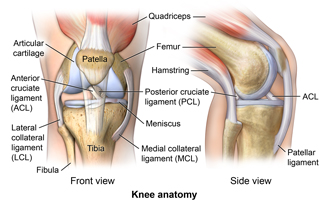Knee pain is a common complaint we hear about in our clinic. There’s a lot going on with our knees, and a lot of different reasons why they can begin to hurt. Typically, people with knee pain fall into two categories – those that have had a traumatic accident and physically injured their knee, and those whose pain has come on spontaneously, with no history of an accident. This blog will investigate common knee injuries and what you can do to help them.
Traumatic Knee Injuries
There are a near infinite amount of ways an individual can hurt their knee – commonly we hear about people who have had a sports injury, taken a fall, or been in a car accident, although there are many different mechanisms of injury which can cause knee injuries. Common traumatic knee injuries include:
- Ligament tears – the most commonly injured ligaments in the knee to be damaged would be the anterior cruciate ligament (or ‘ACL’), followed by the medial and lateral collateral ligaments (or ‘MCL’/ ‘LCL’). Less commonly injured is the posterior cruciate ligament (or ‘PCL’). Ligaments are often injured in sporting related activities. Ligament tears are graded 1 to 3 – grade 1 is a minor injury with minimal fibers of the ligament torn, grade 2 is a moderate injury with an incomplete tear of the ligament, and grade 3 is a major injury with the ligament fully torn.
- Meniscal tears – think of the meniscus like a layer of padding between the bones that make up your knee joint. They can often be injured at the same time as you injure a ligament in your knee, but you can injure your meniscus without injuring your knee ligaments. Common signs of a meniscal injury are your knee locking up, clicking in the knee, and pain. You can also have meniscal injuries without having an accident, through regular ‘wear and tear’ in the knee.
- Dislocated patella (kneecap) – Often occurring when you get hit on the inside of your knee or kneecap, a dislocated patella is where your kneecap gets pushed outwards and away from the knee joint. The patella may return to its original position spontaneously on its own, or you may require a doctor to put it back in place. Regardless of how the patella is relocated, you should always visit the emergency room to make sure there is no fracture of the patella, and a period of immobilization of the leg in a brace or splint will most likely be needed.
Non-Traumatic Knee Injuries
The most common story we hear in the clinic about knee pains are those that seem to come on out of the blue, with no history of an injury or traumatic incident that seemed to cause them. Often, we find the following reasons can explain why people suffer with non-traumatic knee pain:
- Patellofemoral pain syndrome (PFS) – this refers to a pain that can be felt around the knee, but is stemming from an issue with the patella (kneecap), and how it interacts with the rest of the knee joint. PFS often occurs because muscles in the thigh, hip and calf become tight and weak, and/or because the hip or ankle joints aren’t moving properly. It is a very common cause of knee pain.
- Osteoarthritis (OA) of the knee – OA of the knee is a normal, age-related change which can be present but may not be the cause any pain or symptoms in your knee. However, if OA progresses, it can lead to pain, inflammation and limited motion in the knee. This is turn leads to tighter and weaker muscles around the knee, which can caused increased pain and discomfort. OA of the knee is not something you can change, but you can strengthen and relax the tight and weak muscles surrounding the knee joint.
- Muscular knee pain – There are a lot of big muscles that attach into your knees. You have the 4 quadriceps muscles in the front and 3 hamstring muscles in the back of your thigh; your calf muscle and some of your groin muscles also all attach to the bones in your knee. If the muscles are tight, they can pull on the knee bones, causing pain, or trigger points in the muscles (super tight bands of muscle fibers) can refer pain from the tight muscle, into the knee itself. Often, muscular knee pain is a factor in both traumatic and non-traumatic knee pain. IMS/ Dry Needling is a great option to release and relax tight muscles around your knee!
Please note that while the above knee pathologies are common reasons for knee pain, there are several other reasons and diagnoses that can be the cause of your knee pain. Our physiotherapists (see below) can help determine what the diagnosis of your knee pain is.
What can I do if I have knee pain?
If you have knee pain, booking an appointment with one of our physiotherapist’s is a great way to find out what the issue is, and start treatments which are going to help you move forwards. The physiotherapist will take a detailed history of your knee pain, and then examine the knee itself. They will then be able to develop a treatment plan for you, which typically would combine some hands on therapy and exercises to help heal your knee.
If you would like to learn more about our physiotherapy team, click here, or click here if you are ready to book an appointment. We’re hear to help, so feel free to call us at 250-493-1152 if you have any specific questions you would like to ask us!






